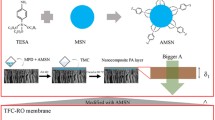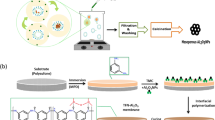Abstract
Poly (lactic acid) (PLA) based biopolymeric membranes are biodegradable and are prone to fouling. In the current study, titanium-coated mesoporous silica (TiO2-MMS) nanocomposites have been incorporated with PLA membranes to enhance the flux performance and separation of chlorophenolic compounds. PLA membranes with TiO2-MMS nanocomposites were prepared using the phase inversion method. The structural, functional and crystalline morphology of the tailored membrane was determined by scanning electron microscopy, energy dispersive X-ray analysis, Fourier transform infrared spectroscopy and X-ray diffraction. The addition of 1.5 wt% of TiO2-MMS nanoparticles to bare PLA polymer enhanced the porosity to 37.93%, water content to 46.86% and contact angle to 59.21°. The designed PLA/TiO2-MMS nanocomposite membrane with a molecular weight cut-off of 9 kDa exhibits a pure water flux of 251.67 Lm−2 h−1. The higher concentration of TiO2-MMS nanocomposite to 1.5 wt% enhances the rejection to 49.5% and 56.8% for pentachlorophenol (PCP) and 2,6 dichlorophenol (DCP), respectively and improved the permeation flux of PCP to 111.08 Lm−2 h−1and DCP to 129.74 Lm−2 h−1. Interestingly, the PLA/TiO2-MMS (1.5 wt%) membrane resulted in a significant increase in flux recovery ratio of 54% for PCP and 58% for DCP, confirming the membrane’s antifouling property. At the same time, irreversible fouling of PCP and DCP of the PLA/TiO2-MMS (1.5 wt%) membrane decreased drastically to 20.5 and 19.11%, respectively. Therefore, biodegradable PLA membrane modified with TiO2-MMS nanocomposite designates its potential application in wastewater treatment plants for the treatment of contaminants.




Similar content being viewed by others
Data Availability
Data are available upon reasonable request.
Abbreviations
- PLA:
-
Poly(lactic acid)
- TiO2-MMS:
-
Titanium coated magnetic mesoporous silica
- PEG:
-
Poly ethylene glycol
- MWCO:
-
Molecular weight cutoff
- PCP:
-
Pentachlorophenol
- DCP:
-
Dichlorophenol
- NMP:
-
N-methyl-2-pyrrolidone
- Rir :
-
Irreversible fouling
- Rr :
-
Reversible fouling
- FDR:
-
Flux decline rate
- FRR:
-
Flux recovery ratio
- XRD:
-
X-ray diffraction
- SEM:
-
Scanning electron microscopy
- ATR-FTIR:
-
Attenuated total reflectance-Fourier transform infrared spectroscopy
References
Singh AK, Bilal M, Jesionowski T, Iqbal HMN (2023) Assessing chemical hazard and unraveling binding affinity of priority pollutants to lignin modifying enzymes for environmental remediation. Chemosphere 313:137546. https://doi.org/10.1016/J.CHEMOSPHERE.2022.137546
Ling Y, Hu S, Chen T et al (2020) Effect of dose rate on degradation of 2,6-dichlorophenol by electron beam irradiation. J Radioanal Nucl Chem 323:975–982. https://doi.org/10.1007/s10967-019-07004-8
Garba ZN, Zhou W, Lawan I et al (2019) An overview of chlorophenols as contaminants and their removal from wastewater by adsorption: A review. J Environ Manage 241:59–75. https://doi.org/10.1016/J.JENVMAN.2019.04.004
Eslami A, Hashemi M, Ghanbari F (2018) Degradation of 4-chlorophenol using catalyzed peroxymonosulfate with nano-MnO2/UV irradiation: Toxicity assessment and evaluation for industrial wastewater treatment. J Clean Prod 195:1389–1397. https://doi.org/10.1016/J.JCLEPRO.2018.05.137
Raza W, Lee J, Raza N et al (2019) Removal of phenolic compounds from industrial waste water based on membrane-based technologies. J Ind Eng Chem 71:1–18. https://doi.org/10.1016/J.JIEC.2018.11.024
Taqvi SIH, Solangi AR, Buledi JA et al (2022) Plant extract-based green fabrication of nickel ferrite (NiFe2O4) nanoparticles: An operative platform for non-enzymatic determination of pentachlorophenol. Chemosphere 294:133760. https://doi.org/10.1016/J.CHEMOSPHERE.2022.133760
Wang X, Wang J, Jiao C et al (2018) RETRACTED: Preparation of magnetic mesoporous poly-melamine-formaldehyde composite for efficient extraction of chlorophenols. Talanta 179:676–684. https://doi.org/10.1016/J.TALANTA.2017.12.002
Abedini R (2019) Enhanced antifouling properties of poly(ethersulfone) nano-composite membrane filled with nano-clay particles. Polym Bull 76:1737–1753. https://doi.org/10.1007/S00289-018-2464-1
Zheng X, Khan MT, Cao X, Croue JP (2021) Importance of origin and characteristics of biopolymers in reversible and irreversible fouling of ultrafiltration membranes. Sci Total Environ 784:147157. https://doi.org/10.1016/J.SCITOTENV.2021.147157
Hussain CM, Paulraj MS, Nuzhat S (2022) Source reduction, waste minimization, and cleaner technologies. Source Reduct Waste Minimization. https://doi.org/10.1016/B978-0-12-824320-6.00002-2
Nasir AM, Awang N, Jaafar J et al (2021) Recent progress on fabrication and application of electrospun nanofibrous photocatalytic membranes for wastewater treatment: A review. J Water Process Eng 40:101878. https://doi.org/10.1016/J.JWPE.2020.101878
de Castro TR, de Macedo DC, de Genaro Chiroli DM et al (2021) The potential of cleaner fermentation processes for bioplastic production: a narrative review of polyhydroxyalkanoates (PHA) and polylactic acid (PLA). J Polym Environ 303(30):810–832. https://doi.org/10.1007/S10924-021-02241-Z
Gu J, Xiao P, Chen P et al (2017) Functionalization of biodegradable pla nonwoven fabric as superoleophilic and superhydrophobic material for efficient oil absorption and oil/water separation. ACS Appl Mater Interfaces 9:5968–5973. https://doi.org/10.1021/ACSAMI.6B13547/SUPPL_FILE/AM6B13547_SI_005.AVI
Zhang ZM, Gan ZQ, Bao RY et al (2020) Green and robust superhydrophilic electrospun stereocomplex polylactide membranes: Multifunctional oil/water separation and self-cleaning. J Memb Sci 593:117420. https://doi.org/10.1016/J.MEMSCI.2019.117420
Samree K, Srithai PU, Kotchaplai P et al (2020) Enhancing the antibacterial properties of PVDF membrane by hydrophilic surface modification using titanium dioxide and silver nanoparticles. Membranes (Basel) 10:1–18. https://doi.org/10.3390/MEMBRANES10100289
Lakhotia SR, Mukhopadhyay M, Kumari P (2019) Iron oxide (FeO) nanoparticles embedded thin-film nanocomposite nanofiltration (NF) membrane for water treatment. Sep Purif Technol 211:98–107. https://doi.org/10.1016/J.SEPPUR.2018.09.034
Vatanpour V, Jouyandeh M, Akhi H et al (2022) Hyperbranched polyethylenimine functionalized silica/polysulfone nanocomposite membranes for water purification. Chemosphere 290:133363. https://doi.org/10.1016/J.CHEMOSPHERE.2021.133363
Chinyerenwa AC, Wang H, Zhang Q et al (2018) Structure and thermal properties of porous polylactic acid membranes prepared via phase inversion induced by hot water droplets. Polymer (Guildf) 141:62–69. https://doi.org/10.1016/J.POLYMER.2018.03.011
Zhang M, Jiang C, Wu Q et al (2022) Poly(lactic acid)/poly(butylene succinate) (PLA/PBS) layered composite gas barrier membranes by anisotropic janus nanosheets compartibilizers. ACS Macro Lett. https://doi.org/10.1021/ACSMACROLETT.2C00139/SUPPL_FILE/MZ2C00139_SI_001.PDF
Chen J, Meng X, Tian Y et al (2020) Fabrication of a superhydrophilic PVDF-g-PAA@FeOOH ultrafiltration membrane with visible light photo-fenton self-cleaning performance. J Memb Sci 616:118587. https://doi.org/10.1016/J.MEMSCI.2020.118587
Nassar L, Hegab HM, Khalil H et al (2022) Development of green polylactic acid asymmetric ultrafiltration membranes for nutrient removal. Sci Total Environ 824:153869. https://doi.org/10.1016/J.SCITOTENV.2022.153869
Rajput S, Pittman CU, Mohan D (2016) Magnetic magnetite (Fe3O4) nanoparticle synthesis and applications for lead (Pb2+) and chromium (Cr6+) removal from water. J Colloid Interface Sci 468:334–346. https://doi.org/10.1016/J.JCIS.2015.12.008
Bu D, Li N, Zhou Y et al (2020) Enhanced UV stability of N-halamine-immobilized Fe3O4@SiO2@TiO2 nanoparticles: Synthesis, characteristics and antibacterial property. New J Chem 44:10352–10358. https://doi.org/10.1039/D0NJ01439G
Bobirică C, Bobirică L, Râpă M et al (2020) Photocatalytic degradation of ampicillin using PLA/TiO2 hybrid nanofibers coated on different types of fiberglass. Water 12:176. https://doi.org/10.3390/W12010176
Syamsul Bahri S, Harun Z, Norhayati W et al (2019) The influence of Fe doped TiO2 as inorganic additive on the properties of polysulfone ultrafitration membrane. Malaysian J Fundam Appl Sci 15:725–730
Aseri NS, Lau WJ, Goh PS et al (2019) Preparation and characterization of polylactic acid-modified polyvinylidene fluoride hollow fiber membranes with enhanced water flux and antifouling resistance. J Water Process Eng 32:100912. https://doi.org/10.1016/j.jwpe.2019.100912
Zhang D, Jin XZ, Huang T et al (2019) Electrospun fibrous membranes with dual-scaled porous structure: Super hydrophobicity, super lipophilicity, excellent water adhesion, and anti-icing for highly efficient oil adsorption/separation. ACS Appl Mater Interfaces 11:5073–5083. https://doi.org/10.1021/ACSAMI.8B19523/SUPPL_FILE/AM8B19523_SI_006.AVI
Sanjeevi S, Shanmugam V, Kumar S et al (2021) Effects of water absorption on the mechanical properties of hybrid natural fibre/phenol formaldehyde composites. Sci Rep 111(11):1–11. https://doi.org/10.1038/s41598-021-92457-9
Hasanuddin NI, Mokhtar WNAW, Othaman R, Anuar FH (2022) Poly(lactic acid)-poly(ethylene glycol)/magnesium silicate membrane for methylene blue removal: Adsorption behavior, mechanism ionic strength and reusability studies. Membranes 12:198. https://doi.org/10.3390/MEMBRANES12020198
Shen H, Li Y, Yao W et al (2021) Solvent-free cellulose nanocrystal fluids for simultaneous enhancement of mechanical properties, thermal conductivity, moisture permeability and antibacterial properties of polylactic acid fibrous membrane. Compos Part B Eng 222:109042. https://doi.org/10.1016/J.COMPOSITESB.2021.109042
Alkarbouly Basma SM, Waisi I (2022) Fabrication of electrospun nanofibers membrane for emulsified oil removal from oily wastewater. Baghdad Sci J. https://doi.org/10.21123/bsj.2022.6421
Shao S, Fu W, Li X et al (2019) Membrane fouling by the aggregations formed from oppositely charged organic foulants. Water Res 159:95–101. https://doi.org/10.1016/J.WATRES.2019.05.004
Xiong Z, Zhong Y, Lin H et al (2017) PDLA/PLLA ultrafiltration membrane with excellent permeability, rejection and fouling resistance via stereocomplexation. J Memb Sci 533:103–111. https://doi.org/10.1016/J.MEMSCI.2017.03.028
Zhou S, Zhang Y, Ni L et al (2021) Applied organic-inorganic nanocomposite of PLA-TiO2 for preparing polysulfone membrane: Structure, performance and UV-assisted cleaning strategy. Water Sci Technol 83:198–211. https://doi.org/10.2166/WST.2020.564
Asadi A, Zinatizadeh AA, Van Loosdrecht M (2018) Hygienic water production in an innovative air lift bioreactor followed by high antifouling ultrafiltration membranes modified by layer-by-layer assembly. J Clean Prod 182:27–37. https://doi.org/10.1016/J.JCLEPRO.2018.02.037
Jafar Mazumder MA, Raja PH, Isloor AM et al (2020) Assessment of sulfonated homo and co-polyimides incorporated polysulfone ultrafiltration blend membranes for effective removal of heavy metals and proteins. Sci Reports 101(10):1–13. https://doi.org/10.1038/s41598-020-63736-8
Lu D, Yao Z, Jiao L et al (2022) Separation mechanism, selectivity enhancement strategies and advanced materials for mono-/multivalent ion-selective nanofiltration membrane. Adv Membr 2:100032. https://doi.org/10.1016/J.ADVMEM.2022.100032
Yang Y, Lan Q, Wang Y (2020) Gradient nanoporous phenolics as substrates for high-flux nanofiltration membranes by layer-by-layer assembly of polyelectrolytes. Chinese J Chem Eng 28:114–121. https://doi.org/10.1016/J.CJCHE.2019.04.011
Mohamat R, Bakar SA, Mohamed A et al (2023) Incorporation of different polymeric additives for polyvinylidene fluoride membrane fabrication and its performance on methylene blue rejection and antifouling improvement. J Polym Environ 31:3466–3479. https://doi.org/10.1007/S10924-023-02774-5/TABLES/4
Sun H, Zhang Y, Sadam H et al (2019) Novel mussel-inspired zwitterionic hydrophilic polymer to boost membrane water-treatment performance. J Memb Sci 582:1–8. https://doi.org/10.1016/J.MEMSCI.2019.03.086
You X, Ma T, Su Y et al (2017) Enhancing the permeation flux and antifouling performance of polyamide nanofiltration membrane by incorporation of PEG-POSS nanoparticles. J Memb Sci 540:454–463. https://doi.org/10.1016/J.MEMSCI.2017.06.084
Wang Q, Zhang S, Dai F et al (2021) Enhanced antifouling property of poly(aryl ether nitrile) ultrafiltration membranes via copolymerization with phenolphthalin. J Environ Chem Eng. https://doi.org/10.1016/J.JECE.2021.106132
Zhou R, Rana D, Matsuura T, Lan CQ (2019) Effects of multi-walled carbon nanotubes (MWCNTs) and integrated MWCNTs/SiO2 nano-additives on PVDF polymeric membranes for vacuum membrane distillation. Sep Purif Technol 217:154–163. https://doi.org/10.1016/J.SEPPUR.2019.02.013
Gumbi NN, Hu M, Mamba BB et al (2018) Macrovoid-free PES/SPSf/O-MWCNT ultrafiltration membranes with improved mechanical strength, antifouling and antibacterial properties. J Memb Sci 566:288–300. https://doi.org/10.1016/J.MEMSCI.2018.09.009
Dasari A, Quirós J, Herrero B et al (2012) Antifouling membranes prepared by electrospinning polylactic acid containing biocidal nanoparticles. J Memb Sci 405–406:134–140. https://doi.org/10.1016/J.MEMSCI.2012.02.060
Moradi G, Zinadini S (2020) A high flux graphene oxide nanoparticles embedded in PAN nanofiber microfiltration membrane for water treatment applications with improved anti-fouling performance. Iran Polym J 29:827–840. https://doi.org/10.1007/S13726-020-00842-4/FIGURES/12
Acknowledgements
The authors would like to extend their gratitude to Sri Ramaswamy Memorial Institute of Science and Technology, Tamil Nadu, India for their help and for aiding in facilitating the research
Funding
No funds, grants, or other support were received during the preparation of this manuscript.
Author information
Authors and Affiliations
Contributions
JG: Data curation; Formal analysis; Methodology; Roles/Writing—original draft; SK Jha: Writing—review and editing; Methodology; DC: Data curation; Formal analysis; AC: Data curation; Formal analysis; VKV: Investigation; Project administration; Supervision; Validation; Visualization,
Corresponding author
Ethics declarations
Competing interest
The authors declare that they have no known competing financial interests or personal relationships that could have appeared to influence the work reported in this paper.
Ethical Approval
Not applicable.
Consent for Participate
Not applicable.
Consent for Publication
Authors have given explicit consent to publish this work.
Additional information
Publisher's Note
Springer Nature remains neutral with regard to jurisdictional claims in published maps and institutional affiliations.
Rights and permissions
Springer Nature or its licensor (e.g. a society or other partner) holds exclusive rights to this article under a publishing agreement with the author(s) or other rightsholder(s); author self-archiving of the accepted manuscript version of this article is solely governed by the terms of such publishing agreement and applicable law.
About this article
Cite this article
George, J., Jha, S.K., Chakrabarty, D. et al. Superior Performance of Titanium Coated Magnetic Mesoporous Silica Nanocomposite Based Poly(lactic acid) Membranes for the Separation of Chlorophenolic Organic Contaminants. J Polym Environ (2023). https://doi.org/10.1007/s10924-023-03098-0
Accepted:
Published:
DOI: https://doi.org/10.1007/s10924-023-03098-0




